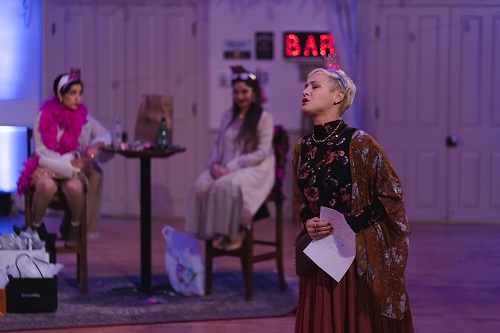 “Riotously funny” Figaro adaptation is a “must see” in Toronto
“Riotously funny” Figaro adaptation is a “must see” in Toronto
Figaro’s Wedding, Against the Grain Theatre‘s remount of their critically acclaimed 2013 production, provides a much needed 21st century facelift to one of the most beloved operas of all time, Le nozze di Figaro. Da ponte’s libretto is full of fluff and nonsense, with a large pinch of subtle (and not so subtle) class critique. However, there are plot points that don’t time travel well, and jokes that are simply not funny to modern sensibilities.
AtG artistic director Joel Ivany’s adaption in modern English cleverly retains the main plot points of the original work and incorporates most of the opera’s iconic musical numbers. But Ivany’s version departs from the original at leisure to tell a very familiar modern-day tale of a millennial wedding beset by family drama, financial woes, and questionable friends.
The audience are guests at the wedding of Figaro and Susanna, a charming young couple who are deeply in love. Unfortunately, the groom’s best man, lifelong friend, and boss cannot be trusted. He has designs on Susanna and can’t stop making creepy advances, under the nose of his beautiful and very lonely wife Rosina (Susanna’s maid of honour). Susanna’s other bridesmaid, Cherubino, is currently the house guest of Rosina and Alberto and has focused her very energetic libido on Rosina. Despite (or perhaps because of) being an incorrigible philanderer, Alberto is very threatened by Cherubino’s advances. Like many weddings, this one has gone over budget and the happy couple is running out of money. Will the wedding actually happen?
This adaptation retains the original’s frothy nonsense and class commentary, but it is a lot easier to get engrossed in the story without the antiquated references to counts and servants, sexist “comedy,” and convoluted plot twists in the original. Like all Against the Grain adaptations I have seen, recitative is eliminated, except where it sets up an aria, and the story is advanced with spoken dialog.
The cast’s enjoyment of this relatable Figaro was palpable and infectious. Both the original and this adaptation provide rich opportunities for over-the-top acting and preposterous gags.
Ally Smither and Bruno Roy had superb onstage chemistry as Susanna and Figaro. They are both outstanding solo singers and their voices blend well together. In Act I, the wedding rehearsal, Roy gave us taste of his ability to blend playfulness and mischief with a warm, open and resonant baritone voice during a hearty performance of Let’s Dance (traditionally Se vuol ballare). This penchant for foolishness was fully realized when he owned the stage in a kinky green velvet Santa suit amidst lusty singing in the Act II finale. The seasonal gag is a great closeout to the general chicanery of the second act.
Vocally, Smither is a perfect Susanna, with the flare for comedic timing and physical comedy that the role needs. Smither’s performance of Deh vieni non tardar, Susanna’s beloved Act III aria, was enchantingly supple, and a perfect vehicle for her silky, light soprano and delightfully fast, stable vibrato.
Her duet with Rosina (Miriam Khalil) in Act III (The Wedding) was glorious. The women compose a series of “sexts” (in lieu of the traditional letter of Sull’aria) to lure Alberto into a trap that will expose his infidelity. Sull’aria is one of Mozart’s most beautiful duets and a great moment of women collaborating and supporting each other.
Miriam Khalil renders a beautiful and complex Rosina, who is much less forgiving than the original Countess Almaviva. She gives a moving performance of the stunning “Porgi Amor” before the other attendees of the bachelorette party arrive at the beginning of Act II. Her rich, velvety and dark soprano is infused with credible pain as she sings of the isolation and neglect she feels in her unhappy marriage. Ivany also makes the intriguing directorial choice to incorporate her current baby bump into the plot, making Alberto’s behaviour all the more loutish.
The last time I saw Figaro, Phillip Addis played the role of the eponymous loveable rogue. He demonstrates a very different side of his vocal and dramatic talent by transforming himself into a cringe-worthy, creepy, and rapacious Count Almaviva. Addis is a seasoned singer who always gives a confident performance and makes it look easy. His dancing during the fourth act reception offered all the joy of Teresa May’s viral video and I was impressed by his facility for physical comedy.
Lauren Eberwein has won my heart in her performances as a member of the COC ensemble studio over the last two seasons. I fell even more in love with her as a lusty, queer Cherubino in this production. The usual pants role is dispensed with and Cherubino is played as a woman into women the whole way through. Her bright, brassy mezzo-soprano was at its finest during a playful performance of a modified Non so piu cosa son, where she sings of her youthful attraction to every person. The much slower paced Voi che sapete, a love song to Rosina, is an excellent showcase of the warmer, juicier timbers available in her voice.
This production is riotously funny and so easy to connect with that it has possibly ruined me for traditional performances of Figaro’s Wedding. The performance takes place in the historic Enoch Turner School House, a popular downtown wedding venue accompanied by string quartet and piano, adding to the authenticity of the wedding premise. An absolute must-see.
Details:
- Figaro’s Wedding is playing until December 20, 2019 at Enoch Turner School House (106 Trinity Street)
- Showtimes are 8 PM on December 3, 4, 5, 9, 10, 11, 13, 14, 18, 19 & 20, with an additional matinee at 4 PM on December 15, 2019.
- Tickets prices range from $35-90. General admission: $55, VIP: $90, Youth (under 25): $35.
- Tickets are available online.
Photo of Alexandra Smither, Miriam Khalil and Lauren Eberwein by Taylor Long
